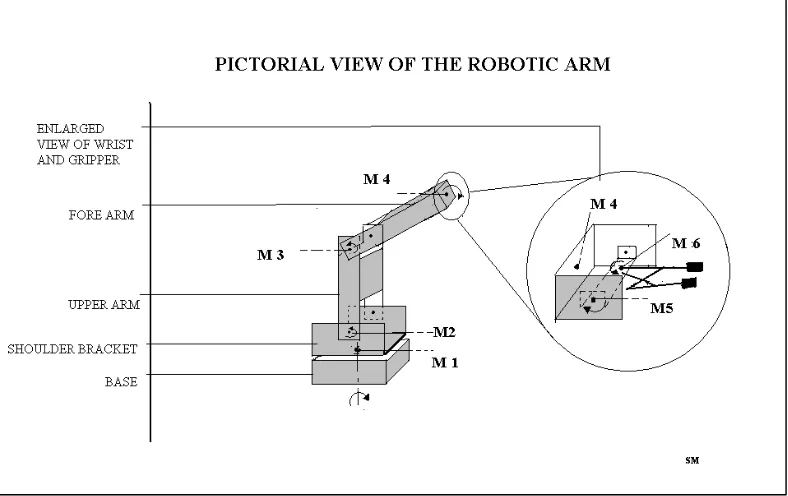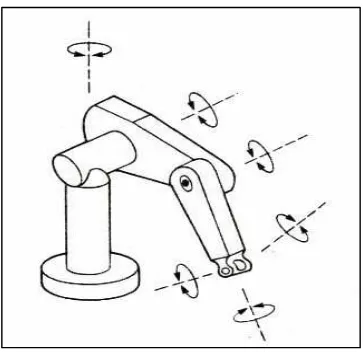GENERAL ROBOTIC ARM
MOHD SYAMSUHADA BIN BAKRI
This report is submitted in partial fulfilment of the requirements for award of Bachelor of Electronic Engineering (Industrial Electronics) With Honours
Faculty of Electronic and Computer Engineering Universiti Teknikal Malaysia Melaka
!
mengaku membenarkan Laporan Projek Sarjana Muda ini disimpan di Perpustakaan dengan syarat-syarat kegunaan seperti berikut:
"# $%& ' ( ) * * +, ) + ' -.&/ 0 .+' + ) ) / .) + #
# .&$1/0 + ' ( 2.' &+ ' ,.,21 0 / ) ' ' 1'01+ 0131 ' $.'4 3 ' / * 3 #
5# .&$1/0 + ' ( 2.' &+ ' ,.,21 0 / ) ' ' ) $%& ' ' /.2 4 2 * ' $.&01+ & ' '0 & '/0 01/ $.'4 3 ' 0 '44 #
6# ) 0 '( + ' ! !
"
.'4 '(1'4 , +)1, 0 '4 2.&( &3 * +./.) , 0 ' 0 1 +.$.'0 '4 ' ) / /.$.&0 '4 0.&, +012 ( ( ) ,
" 7 !
" .'4 '(1'4 , +)1, 0 0.&* ( '4 0.) * ( 0.'01+ ' %).*
%&4 ' / / 2 ( ' ( , ' $.' .) ( + ' ( 3 ) '+ '!
/ *+ ' %).*
88888888888888888888888888 88888888888888888888888888888888888
! 9 !
) , 0 .0 $ #$%
% %
&'())% # % #
“ I hereby declare that this report is the result of my own work except for quotes as citied in the references.”
Signature : ………...…….
Author : MOHD SYAMSUHADA BIN BAKRI
-“I hereby declare that I have read this report and in my opinion this report is sufficient in terms of the scope and quality for the award of Bachelor of Electronic
Engineering (Industrial Electronics) With Honours.”
Signature :………...
Supervisor’s Name : MR.ZULHAIRI BIN OTHMAN
-ACKNOWLEDGEMENTS
-ABSTRACT
-ABSTRAK
-CONTENTS
CHAPTER INSIDE PAGES
PROJECT TITLE i
REPORT APPROVAL FORM ii
DECLARATION iii
ACKNOWLEDGEMENTS v
ABSTRACT vi
ABSTRAK vii
CONTENTS viii
LIST OF TABLE xii
LIST OF FIGURE xiii
LIST OF ABBREVIATION xv
LIST OF APPENDIX xvi
1 INTRODUCTIONS
1.1 Overview 1
1.2 Objectives 2
1.3 Scopes 2
1.4 Methodology 3
1.5 Progress Flow Chart 4
2 LITERATURE REVIEW
2.1 Robot 6
2.2 Robot Arm 7
:
2.3.1 Revolute Coordinate Robot Arm 10 2.3.2 Polar Coordinate Robot Arm 10 2.3.3 Cylindrical Coordinate Robot Arm 11 2.3.4 Cartesian Coordinate Robot Arm 11
2.4 Microcontroller 11
2.5 What Is A Microcontroller 12
2.6 Why Use A Microcontroller 12
2.7 The Compiler 12
3 SOFTWARE
3.1 Code Explorer 15
3.2 Compiler Results 15
3.3 Real Time Simulation Support 16
3.4 General Review Function Descriptions
16
3.5 Operating The Servomotor 18
4 MECHANICAL PART
4.1 The Arm 22
4.2 Selection Of Motors 23
4.2.1 Stepper Motors 23
4.2.2 Dc Motors 24
4.2.3 Servomotor 26
4.3 Motors Used In Project 26
4.4 PWM Generation For Servo Motor Control 27
5 ELECTRONICS
:
5.2 PIC Specification 30
5.2.1 Important Pins 30
5.2.2 Register Control 31
5.2.3 Using A/D Converter 31 5.2.4 Generating PWM Signals 31
5.3 Power Supply 32
5.3.1 Power Supply for the Servo Motors 32 5.3.2 Power Supply for Other Electrical
Devices 33
6 ROBOT CONSTRUCTIONS
6.1 Basic Servomotor Bracket Assembly 35
6.2 Robotic Arm Base 35
6.3 Robotic Arm Links 35
6.4 Servo Motor Specifications 40
6.5 Servomotor Information 43
6.6 Servomotor In My Project 44
6.7 Servo Speed 45
6.8 Servo Torque (Power) 46
6.9 Servo Ratings 47
6.9.1 Servo Wire Information 48
6.9.2 Servomotor Safety 48
6.9.3 Servo Centering 49
6.9.4 Inverse Kinematics 51
7 ROBOT ARM OPERATIONS
7.1 Manual Control 53
7.1.1 Speed Position 54
7.1.2 Save Button 54
7.2 PC Control 55
:
7.2.2 Speed Slider Control 57
7.2.3 Script Writing 57
7.2.4 Playback 58
7.2.5 Script File Handling 58
7.3 Discussions 59
7.4 Conclusions 62
REFERENCES 63
:
LIST OF TABLE
NO TITLE PAGE
Table 1 Motor Control Bits 25
Table 2 Servomotor Bracket Compatibility 36
:
LIST OF FIGURE
NO TITLE PAGE
Figure 1 Pictorial View of the Robotic Arm 3
Figure 2 Anthropomorphic Type of
Robot Design (Selig, 1992, p.29)
8
Figure 3 The six axes Puma robot arm with the TUM multi-fingered hand fixating a wooden “Baufix” toy airplane. The 6D force-torque sensor (FTS) and the end-effectors mounted camera is visible, in contrast to built-in proprioceptive joint encoders.
9
Figure 4 Block Diagram for Microcontroller 12
Figure 5 Robotic arm software flowchart 16
Figure 6 System Block Diagram 20
Figure 7 Sub-System Block Diagram 20
Figure 8 Micro Controller Block Diagram 21
Figure 9 Comparison of servo with stepper having same torque
24
Figure 10 H Bridge using switches 25
Figure 11 H-Bridge circuit using Nmos 25
Figure 12 Servo control signal 27
Figure 13 Timing diagram for PWM generation 28
:
-Figure 15 PIC 16F873 30
Figure 16 Servomotor power supply 32
Figure 17 Power supply for other devices 33
Figure 18 Circuit for Robotic Arm 34
Figure 19 Servo Holder 36
Figure 20 U Joint 36
Figure 21 Robot Arm Base 37
Figure 22 Robot Construction Mechanical Drawing 38
Figure 23 Robot Arm Links 39
Figure 24 Servomotor C36S 40
Figure 25 Servomotor C55S 41
Figure 26 Servomotor C40S 42
Figure 27 Servomotor View 43
Figure 28 Servomotor Speed 45
Figure 29 Servomotor Torque 46
Figure 30 Circuit Layout Power Supply 47
Figure 31 Servomotor Wire Information 48
Figure 32 Servomotor Centering 50
Figure 33 Arm Angle Designations 51
Figure 34 Sample plot of arm simulation 52
Figure 35 Servo Motor Controller 55
:-LIST OF ABBREVIATION
PWM Pulse Width Modulation
DOF Degree of Freedom
PIC Peripheral Interface Controller
FTS Force Torque Sensor
CPU Central Processing Unit
RAM Random Access Memory
ROM Read Only Memory
SFRs Special Function Registers
I/O Input/Output
A/D Analog To Digital
D/A Digital To Analog
IDE Integrated Development Environment
VSM Virtual System Modelling
AC Alternating Current
DC Direct Current
CW Clockwise
MAN Manual
:-APPENDIX
NO TITLE PAGE
A. C Programming 64
B. Robot Arm Article 70
C. Datasheet 16f873 74
D. R/C Servo Function 77
E. Servo Mechanics 78
F. Servo Checker 78
G. PCB Layout 80
H. 3D Layout 81
I. Types of Robotic 82
CHAPTER 1
INTRODUCTIONS
This report describes the design and implementation of a 5 axis robotic arm designed for the BENU 4973 course. The arm moves in a range to get the exact position and size of an object, and then grips the object and moves it to the selected destination. The arm consists of a base, three links and a gripper. The joints and the gripper are activated using servomotors. This report discusses the system overview followed by the mechanical and programming design description. It will also discuss the implementation issues and provide recommendations as to how the design may be improved.
1.1 OVERVIEW
1.2 OBJECTIVES
The purposes of this project are: 1. To develop a robotic arm.
2. To present, analyze, design and troubleshoot the product.
3. To familiarize with the PIC programming and the simulation software. 4. To control the robot arm manually or autonomously.
5. To be able to perform certain tasks we define for it. 6. The tasks must be achieved within some given limitations.
1.3 SCOPES
The arm is the main structure consisting of a mechanical structure, servomotors, and power supply.
The arm is a 5 axis robotic manipulator consisting of a stationary base, three links and a gripper. The five axes consist of the following: (shown in figure 1)
1. Shoulder, elbow, wrist (vertical movement) 2. An axis at the base (horizontal movement) 3. Finger (gripping movement)
Figure 1: Pictorial View of the Robotic Arm
1.4 METHODOLOGY
1. The method employed in designing and constructing the robotic arm are based on the operational characteristics and features of the microcontrollers, servo motors, the electronic circuit diagram and most importantly the programming of the microcontroller and servo motors.
2. To design a robotic arm that can follow a sequence of precise movements. 3. Constructs the project in a time range.
4. To know the concept of robotic arm this is from the design, programming and troubleshooting.
- !
-"#
$
"#
% &
"#
!
'
$
(
) ! (*
+
The flowchart shown that, my progress project flowed.
,
CHAPTER 2
LITERATURE REVIEW
The robotic projects extensive use of the PIC series of microcontroller from Microchip Technology Inc. In addition to its ability to run programs, the microcontroller has input and output lines (pins) that are used to control motor drive systems, read sensors, and communicate. I demand a lot from my microcontroller, so it’s important to have a good idea of what a microcontroller is right from the start.
2.1 ROBOT
1. One of the mechanical men and women in Capek’s play; hence, a machine
(sometimes resembling a human being in appearance) designed to function in place
of a living agent, esp. one which carries out a variety of tasks automatically or with a
minimum of external impulse.
2. A person whose work or activities are entirely mechanical; an automaton.
Oxford English Dictionary, Online Edition.
Karel Capek used the word Robot in his 1921 play Rossum’s Universal Robots,
derived from the Czech word robota, meaning ‘‘forced labor.’’ These Robots were
created to replace man and, in their simplified form, as cheap labor. Robots had
perfect memory but were incapable of thinking new thoughts. They mirrored the
Hebrew legends of the golem, a clay statue that has had life breathed into to by
mystical means. And, of course, this all sounds a lot like Dr. Frankenstein’s monster,
-stories have in common is that the creation is ultimately the downfall of their creator
robots, golems, and reanimated flesh means trouble. They are an illustration of what
happens when we reach too far and are bitten by the unintended consequences.
2.2 ROBOT ARM
The word ‘robotics’, meaning the study of robots was coined by Isaac Asimov. Robotics involves elements of mechanical and electrical engineering, as well as control theory, computing and now artificial intelligence (Selig, 1992).
According to the Robot Institute of America, “A robot is a reprogrammable, multifunctional manipulator designed to move materials, parts, tools or specialized
devices through variable programmed motions for the performance of a variety of
tasks”(Robotics Research Group, n.d.)
The fact that a robot can be reprogrammed is important: it is definitely a characteristic of robots. In order to perform any useful task the robot must interface with the environment, which may comprise feeding devices, other robots, and most importantly people.
.
Figure 2: Anthropomorphic Type of
Robot Design (Selig, 1992, p.29)
To control the robot arm I decide to use microcontroller. In this case I saw that, there is a several type can be used to control the robot arm. Taking a look back at the history of robot development, a special kind of human-size industrial robotic arm called Programmable Universal Machine for Assembly (PUMA) came into existence. This type of robot is often termed anthropomorphic because of the similarities between its structure and the human arm. The individual joints are named after their human-arm counterparts. “It is worth noting that in our work, the hand is magnetic and not a generalized manipulator. In the proper sense of the word,
manipulation is the function of the arm. The function of the arm is to position and
orient the hand, act as a mechanical connection and power and sensing transmission
link between the hand and the main body of the person. The full functional fearing of
the arm rests in the hand” (Bejczy & Jau, 1986). This work provides important elements that are required to build a simple robotic arm of very high quality. As stated earlier it can be making use of the 8051-based microcontroller. ‘The 8051’s instruction set is optimized for one-bit operations that are often desired in real
world, real time operations’. (Pont, 2002).
The first design was for experimental use on a human-size industrial robot
arm called PUMA 560 used to explore issues in versatile object handling and

